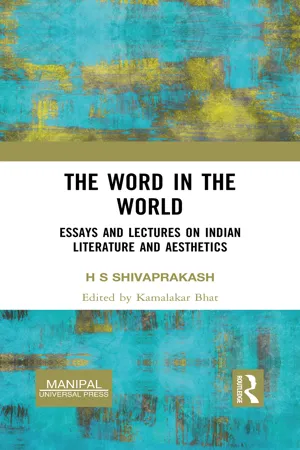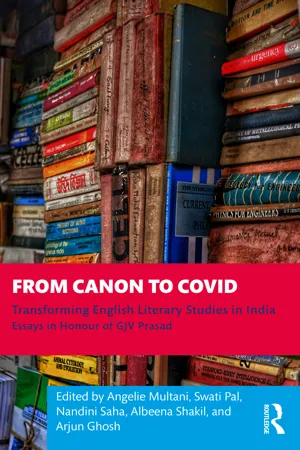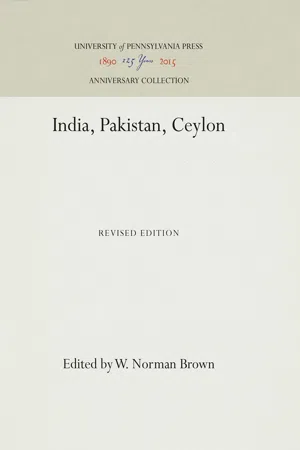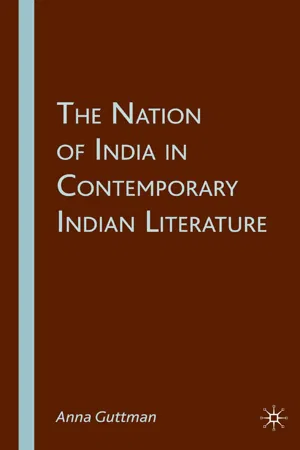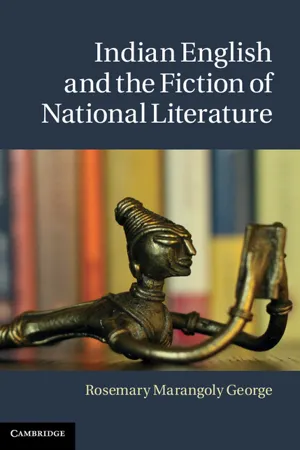Literature
Indian Literature
Indian literature encompasses a rich and diverse body of written works in various languages, including Sanskrit, Tamil, Hindi, Bengali, and many others. It reflects the cultural, social, and historical experiences of the Indian subcontinent, addressing a wide range of themes and genres such as epics, poetry, drama, and fiction. Indian literature has made significant contributions to world literature and continues to evolve with contemporary voices and perspectives.
Written by Perlego with AI-assistance
Related key terms
1 of 5
8 Key excerpts on "Indian Literature"
- eBook - ePub
Masterworks of Asian Literature in Comparative Perspective: A Guide for Teaching
A Guide for Teaching
- Barbara Stoler Miller(Author)
- 2016(Publication Date)
- Routledge(Publisher)
The Princeton Encyclopedia of Poetry and Poetics. 2d ed. Princeton: Princeton University Press, 1990.Dimock, Edward C., et al. The Literatures of India: An Introduction. Chicago: University of Chicago Press, 1974.Embree, Ainslie, ed. Sources of Indian Tradition. Vol. 1, From the Beginning to 1800. 2d ed. New York: Columbia University Press, 1988.Hay, Stephen, ed. Sources of Indian Tradition. Vol. 2, Modem India and Pakistan. 2d ed. New York: Columbia University Press, 1988.Warder, A. K. Indian Kāvya Literature. 4 vols. Delhi: Motilal Banarsidass, 1972–83.Passage contains an image
David RubinA NOTE ON MODERN Indian LiteratureThe literatures of India in the twentieth century, and particularly since independence in 1947, have flourished both in English and in the many Indian regional languages. Fiction and poetry are probably the most widely cultivated genres, though drama and criticism are gaining in both frequency and maturity. Only a small amount of this writing has been translated into English. Therefore, ironically, it is mainly works written originally in English, called Indo-Anglian, that have become well known in the West.Both the abundance and the variety of twentieth-century Indian Literature make a brief survey of it next to impossible. Getting an accurate overall picture of writing in the entire Subcontinent is rendered still more complicated by the fact that few critics command more than two or three of the many regional languages in which worthwhile literature is being produced. (This explains why most of the references in this essay will be to works written in Hindi, Urdu, and Bengali, in addition to English.) The following remarks are meant to serve as a very general guide for the interested Western reader. - eBook - ePub
The Word in the World
Essays and Lectures on Indian Literature and Aesthetics
- H S Shivaprakash, Kamalakar Bhat(Authors)
- 2023(Publication Date)
- Taylor & Francis(Publisher)
In spite of having an uninterrupted history of 200 years, Indian Literatures, written in 22 officially recognized major languages, countless tribal languages and in foreign languages like Persian, English, French and Portuguese, the many-faceted literary output of India constitutes one of the richest achievements of mankind in the world. A huge body of written literatures is complimented by a larger body of oral texts still being produced in tribal languages of the sub-continent. Indian writings in every genre of creative writing are flourishing and making new breakthroughs.It was during the anti-colonial struggle that modern Indian Literatures came of age. Indians then started looking at themselves and the rest of the world with their eyes chastened by colonial education. In order to keep pace with the other developed literatures of the world and to enrich our literary scene with Western influences, they created new genres of literature unknown to the past. Fiction, essay, lyrical poetry, drama, criticism, literary history: these forms, though borrowed from West, were refashioned to suit Indian needs.Apart from revolution in forms, the substance of writings underwent a sea-change. The increasing pace of industrialization and urbanization exposed literary imagination to city experiences. The impact of science and rationalism invited writers to critique institutions and practices that would not stand up to rational scrutiny. Conventions became targets of attack. The other worldly concerns of pre-modern literatures gave way to an increasing inquisitiveness about the actual world around. Apart from pulling down the old gods, Indian creativity invented new gods, the chief of whom was man in society and nature.Some of the above values had already entered literary imagination in the precursors of modernity like the great Urdu poet Mirza Ghalib, who personified the angst of a modern artist not any more at home with religion or happy with the state. Neither could he find any still centre in his own self. - eBook - ePub
From Canon to Covid
Transforming English Literary Studies in India. Essays in Honour of GJV Prasad
- Angelie Multani, Swati Pal, Nandini Saha, Albeena Shakil, Arjun Ghosh, Angelie Multani, Swati Pal, Nandini Saha, Albeena Shakil, Arjun Ghosh(Authors)
- 2023(Publication Date)
- Routledge India(Publisher)
6 of the genre from the West either to reinforce their arguments or mark their points of departure. They were the first to introduce the concept of ‘Hindustani’ or ‘Indian’ literature, though the contours of that literature remained limited, fuzzy and problematic. When Indians began to write their own histories of literature, they concentrated on specific languages, rather than the generic ‘Indian’ literature, which always offered challenges of an unimaginable magnitude. Hans Harder is right when he says,The bulk of literary histories that are to be found in India, and that are on the whole produced with unabating frequency, are not histories of Indian Literature, but histories of literature in one specific language, usually written either in that very language or in English(Harder 14 )Much before Harder, Sujit Mukherjee, too, flagged this issue in his monograph, Towards a Literary History of India:Most of our histories of regional literatures are no more than descriptive accounts of literary works and their authors in these languages, with demonstrably greater emphasis on the historical aspect of the enterprise than on the literary. Of course, our traditions of literary criticism themselves are not fully evolved and this continues to be a great handicap in the general area of literary research, whether in theory or in history or in criticism.(Mukherjee 1975 : 9)What Mukherjee says about the state of literary criticism in India has changed much in the intervening period of nearly half a century. Our literary histories ought to come abreast with the trends and developments that have taken place during this period. - eBook - PDF
English across Cultures. Cultures across English
A Reader in Cross-cultural Communication
- Ofelia García, Ricardo Otheguy(Authors)
- 2012(Publication Date)
- De Gruyter Mouton(Publisher)
All illustrations will be drawn from Indian writing in English. There is need for studying language varieties in literature from both the linguistic and non-linguistic points of view. The sociology of literary language being postulated here as a broad cover term will take into consideration the interplay between semantic components, pragmatic functions and contextual features that determine the linguistic and stylistic choices in a work of literature. Such an inclusive use of language in the domain of literature finds a forceful expression in the words of William Walsh, Literature in the end is only — only — the most powerful, the most human, the subtlest and the most inclusive use of language (Walsh 1982:101). 2. The use of English in Indian creative writing. Linguistic and sociocultural limitations. Often serious doubts are expressed regarding the Indian's competence in using a foreign language as a medium for creative writing. Kantak finds Indian writing in English in a state of perpetual curse: An unfriendly spirit (incarnate as a mocking bird) hovers over all efforts Indian Literature in English 423 at creative writing in an alien tongue (Kantak 1977:223). As early as 1937 Yeats, too, dissuaded Indian authors from writing in English: I begged the Indian writers present to remember that no man can think or write with music and vigour except in his mother tongue (Yeats 1973:23). Over a hundred years ago a reporter of The Times (London) remarked that a thoughtful Englishman would think of Indian writing in English in the same fashion as Cicero would pro-bably think of much of the Ciceronian Latin that is written at our schools and universities ( The Times, 1982, April 11:8). And recently, Pandeya has remarked: Of all the non-native English writers in the Commonwealth countries the Indian novelist is probably the most deficient in his handling of the language (Pandeya 1983:174). - eBook - PDF
- W. Norman Brown(Author)
- 2016(Publication Date)
Buddhist stories have gone by way of the Jätaka collection and other works to Ceylon, Burma, Malaya, Thailand, Cambodia, and Indonesia, and secular tales and Hindu religious legends have gone to some of these regions through such media as the Panchatantra (Sanskrit Pancatantra ) collection or the Hindu epic Rämä-yana. Many have also gone to Tibet, Central Asia, China, Iran, and Arabia, and some to Europe. In the regions of India where there is a strong literary tradition, the quality of the oral tales is likely to be better than in those with little or no literary tradition. For example, in the hill regions of Madhya Pradesh, where numerous tales have been collected from peoples whose languages are un-written, the stories are often poor in plot and detail, while the narrators rarely seem able to sustain a long narrative. There is much repetition in both oral and literary tales of motifs, themes, and incidents, and it is impossible to separate the one class of fiction sharply from the other. There are a few motifs, such as the life index or life token, which have a wide prevalence in the folklore and yet only rare occurrence in the literature, and a few other motifs and even story types which are limited to one or two people, such as the Santals and the Hos, speakers of nonliterate languages, whose dependence upon Indian Literature for their fiction is slight. Throughout the areas with literatures, however, there is a great deal of fiction material which is held in common. Indian Literature IN ENGLISH by Dorothy M. Spencer WITH the introduction and spread of English education in India after 1835, many Indians began to write in English, and while the greater part of creative writing since the mid-19th century has been in the vernacular languages, a considerable body of material in English has accumulated. This material varies greatly in quality, but at least a few Indians writing in English have become masters of style and of their chosen form. - A. Guttman(Author)
- 2007(Publication Date)
- Palgrave Macmillan(Publisher)
It also examines one of the major sources of this ideal, namely, the writings of India’s first prime minister, Jawaharlal Nehru. How have the events of the nearly sixty years that have elapsed since Indian independence challenged or reinforced the ideals on which the nation was founded? In order to understand the answer to this question, it is necessary to both situate the question of representing India in contemporary theory and under- stand the specific history of national self-representation on the subcontinent. A. Guttman, The Nation of India in Contemporary Indian Literature © Anna Guttman 2007 2 ● The Nation of India in Contemporary Indian Literature Therefore, in the first section of this introduction, I briefly situate this study with respect to major theorizations of the nation, emphasizing the ways in which the specificities of Indian history both coincide with and deviate from more general theories of the nation such as that of Benedict Anderson’s Imagined Communities. The second section focuses on the issue of national language. Anderson emphasizes that the nation is a linguistic unit, but the Indian nation-state arguably lacks a national language. I present a brief history of the national-language debate and the problem of associating with the nation any language used in India. Though this study focuses on fiction writ- ten in English, it does not argue that English is the definitive language of India or the only literary language of value. Nevertheless, English does occupy a unique position in Indian political and literary history. The status and history of the Indian novel in English is the subject of the third section of this introduction. The novel occupies a special place in discussions of literary history and nationality, and, with the exception of chapter 1, will be the primary focus of this book. As the novel is an imported genre, however, the relationship between the novel and the nation in India cannot be the same as in the West.- Rosemary Marangoly George(Author)
- 2013(Publication Date)
- Cambridge University Press(Publisher)
Fueled by nationalist fervor, English language representations of modern India work hard to paint a picture of a forward-looking people who are ready for nationhood where detractors had dismissingly noted only a plethora of often antagonistic religious, linguistic, caste, class, and regional groups each looking toward their own parochial interests. As the transfer of power took place, it became clear that the need to stress and safeguard the frail unity of the new nation, especially after the trials of Partition, was an even more urgent task. And as the debates around the selection of a national language for the newly formed nation revealed, the abundance of Indian regional vernaculars which competed against each other for a more significant role on the national stage meant that English had a continued role to play in the imagining/imaging of the new nation. Furthermore, as this chapter will go on to argue, in the last quarter of the twentieth century with the advent of postcolonial literary studies, this imperative on Indian literary writing in English to translate India to itself and to the world received a further boost. Postcolonial literary analysis was a global discourse that, of necessity, had to be conducted in English and relied on “representative” national cultural texts from formerly colonized spaces that were written in English or had been translated into this language. In this chapter I elaborate on this narrative about English in India and the complex proximity of the literary and the national in the decades around 1947 and the resurgence of this proximity in the era of postcolonial prescriptions for literary writing from former colonies. I A detailed assessment of Indian Literature in English cannot (or should not) begin without an account of the place of English in postcolonial Many a slip between the literary and the national 15 India.- eBook - PDF
Imagining Indianness
Cultural Identity and Literature
- Diana Dimitrova, Thomas de Bruijn, Diana Dimitrova, Thomas de Bruijn(Authors)
- 2017(Publication Date)
- Palgrave Macmillan(Publisher)
Perhaps more than intended, the young authors saw themselves forced to formulate their literary argument in terms of the contribution of their fiction to the new nation’s culture and identity. Debates on the ‘Indianness’ of Indian Literature will always be around in the literary and cultural discourse in India. They are a remnant from the beginnings of modern writing in Hindi, when forming an ‘Indian’ nation was at stake. This made Indianness the primary ideological axis of the literary field of Hindi writing. In the course of the 1960s, the impact of the proposed innovations of Nayı̄ Kahānı̄ on fundamental notions of what modern Indian Literature should be could not be dismissed. The movement had brought a more shaded and ambivalent perception of Indian ideals and icons, which had been around in Hindi writing for much longer, to the center to the literary field. INDIANNESS AS A CATEGORY IN LITERARY CRITICISM ON NAYĪ KAHĀNĪ 73 NOTES 1. In Nayı ̄ Kahānı ̄ kı ̄ bhūmikā (1966) Kamleshvar refers to earlier modern Hindi writing as a kind of rı ̄ tikāl in which mannerisms and Freudian introspection had taken away the focus from the Indian environment of the characters; they had come loose from their background. He also criticizes the progressive writers for turning their characters into idealist stereotypes who represented ideas rather than real-life humans (1966, 9–20). 2. This discussion is conducted by Ramesh Gaur and was first pub- lished by him in the magazine Kendu. It is included under the head- ing Samkā lı ̄ n hindı ̄ kahā nı ̄ : ek paricarcā (Rakesh 1975, 55–80). 3. All translations from Hindi sources are by the present author. 4. The scope of this chapter does not allow for an enumeration of all the places where this topic is discussed by writers and critics. The arguments that are referred to here are repeated many times and also appear in other contexts.
Index pages curate the most relevant extracts from our library of academic textbooks. They’ve been created using an in-house natural language model (NLM), each adding context and meaning to key research topics.

